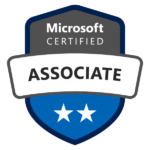
Exam AZ-104 : MS Azure
Azure pre-requisites
Before attending this course, students must have the following technical knowledge:
- Completed the Microsoft Certified Systems Administrator (MCSA) certification in Windows Server 2012/2016 or Windows Server 2019.
- Understanding of on-premises virtualization technologies, including: VMs, virtual networking, and virtual hard disks.
- Understanding of network configuration, including: TCP/IP, Domain Name System (DNS), virtual private networks (VPNs), firewalls, and encryption technologies.
- Understanding of websites, including: how to create, configure, monitor and deploy a website on Internet Information Services (IIS).
- Understanding of Active Directory concepts, including: domains, forests, domain controllers, replication, Kerberos protocol, and Lightweight Directory Access Protocol (LDAP).
- Understanding of resilience and disaster recovery, including backup and restore operations.
About this Course
This course teaches IT professionals how to provision and manage services in Microsoft Azure. Students will learn how to implement infrastructure components such as virtual networks, virtual machines, containers, web and mobile apps, and storage in Azure. Students also will learn how to plan for and manage Azure AD, and configure Azure AD integration with on-premises Active Directory domains.Audience profile.This course is intended for IT professionals who have some knowledge of cloud technologies and want to learn more about Azure.
This course is intended for:
-
- IT professionals who want to deploy, configure, and administer services, containers, and virtual machines (VMs) in Azure.
- IT professional who use Microsoft System Center to manage and orchestrate server infrastructure.
- Windows Server administrators who are looking to evaluate and migrate on-premises Active Directory roles and services to the cloud.
- IT professionals who want to use Azure to host websites and mobile app back-end services.
- IT professionals who are experienced in other non-Microsoft cloud technologies, meet the course prerequisites, and want to cross-train on Azure.
- IT professionals who want to take the Microsoft Certification Exam AZ103
At course completion After completing this course, students will be able to:
- Describe Azure architecture components, including infrastructure, tools, and portals. Implement and manage virtual networking within Azure and configure cross-premises connectivity.
- Plan and create Azure VMs.
- Configure, manage, and monitor Azure VMs to optimize availability and reliability.
- Implement Azure App Service.
- Plan and implement storage, backup, and recovery services.
- Implement container-based workloads in Azure.
- Deploy, configure, monitor, and diagnose cloud services.
- Implement Azure AD.
- Manage an Active Directory infrastructure in a hybrid environment.
- Automate operations in Azure by using Azure Automation runbooks.
COURSE CONTENTS
Content Outline
I.Introduction to Cloud Computing
2.Similar concepts
3.Characteristics
4.Service models
4.1 Infrastructure as a service (IaaS)
4.2 Platform as a service (PaaS)
4.3 Software as a service (SaaS)
4.4 Mobile “backend” as a service (MBaaS)
4.5 Serverless computing
4.6 Function as a service (FaaS)
4.7 Firewall as a Service(FWaas)
5.0 Deployment models
5.1 Private cloud
5.2 Public cloud
5.3 Hybrid cloud
6.Architecture
7.Security and privacy
8.Limitations and disadvantages
II.Virtualization
Introduction
DEPLOYING VIRTUAL MACHINES
HYPERVISOR
Type1 Hypervisor, Type2 Hypervisor
Types of Hardware Virtualization
- Full Virtualization
- Emulation Virtualization
- Paravirtualization
III. Azure Administration
Module 1: Introduction to Microsoft Azure
Cloud technology overview
Overview of Azure
Managing Azure with the Azure portal
Managing Azure with Windows PowerShell
Overview of Azure Resource Manager
Azure management services
Module 2: Implementing and managing Azure networking
Overview of Azure networking
Implementing and managing virtual networks
Configuring Azure virtual network
Configuring virtual network connectivity
Overview of Azure networking in IaaS
Module 3: Implementing virtual machines
Overview of IaaS virtual machines
Planning for Azure Virtual Machines
Deploying IaaS virtual machines
Authoring Azure Resource Manager templates
Overview of IaaS virtual machines
Module 4: Implementing virtual machines
Configuring virtual machines
Configuring virtual machine disks
Configuring virtual machine Scale Set
Configuring virtual machine availability Set
Managing and monitoring Azure virtual machines
Managing IaaS virtual machines
Module 5: Implementing Azure App Service
Introduction to App Service
Planning app deployment in App Service
Implementing and maintaining web apps
Configuring web apps
Monitoring web apps and WebJobs
Implementing mobile apps
Traffic Manager
Module 6: Planning and implementing storage, backup, and recovery services
Planning storage
Implementing and managing Azure Storage
Implementing Azure Storage Explorer
Implementing Azure content delivery networks
Implementing Azure Backup
Planning and implementing Azure Site Recovery
Module 7: Planning and implementing Azure SQL Database
Planning and deploying Azure SQL Database
Implementing and managing Azure SQL Database
Managing Azure SQL Database security
Monitoring Azure SQL Database
Managing Azure SQL Database business continuity
Module 8: Implementing PaaS cloud services
Planning and deploying PaaS cloud services
Managing and maintaining cloud services
Module 9: Implementing Azure Active Directory
Creating and managing Azure AD tenants
Configuring application and resource access with Azure AD
Overview of Azure AD Premium
Azure AD Multi Factor Authentication
Azure AD Registered Devices
Azure AD with Role-Based Access Control (RBAC)
Azure AD with Custom DNS
Module 10: Managing an Active Directory infrastructure in a hybrid environment
Extending an on-premises Active Directory domain to Azure
Implementing directory synchronization by using
Azure AD Connect
Module 11: Implementing Azure-based management and automation (Theory)
Implementing OMS
Implementing Azure Automation
Implementing Automation run books
Managing Azure Automation
Module 12: Implementing Azure Infrastructure and Managent
Azure Resources Groups
Azure Network Security Groups
Azure File Sync
Azure Cost Management and Billing
Azure Pricing Calculator
Azure Virtual Network (VPC)
